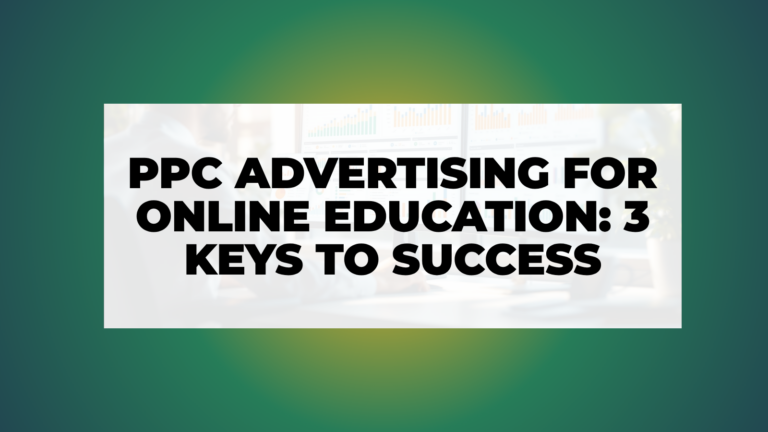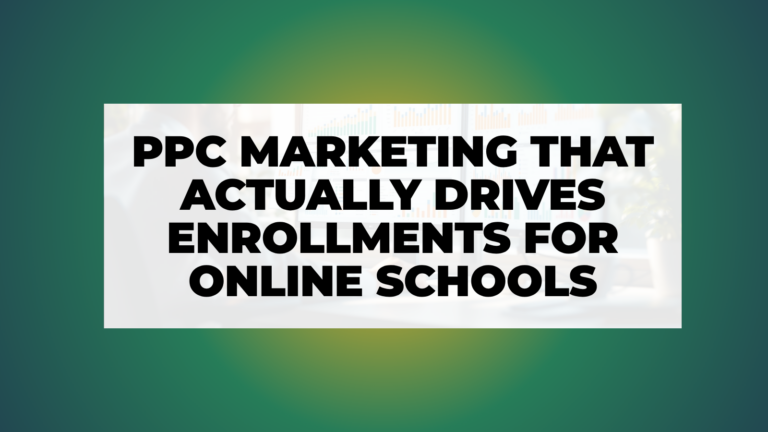Pouring money into Meta ads for your online school, but seeing no return in enrollments?
It’s a frustrating scenario, especially if your Google Ads campaigns are performing well. The problem likely isn’t your school itself, but how you’re approaching Meta.
Think of it like this: Google connects you with people actively searching for what you offer. They’re looking for a solution.
Meta, on the other hand, drops in on people scrolling through their social feeds. Completely different mindset.
This fundamental difference demands a shift in strategy. So after working with millions of dollars in ad spend, here are the most important aspects you need to address to make the platform work: conversion tracking and your overall communication strategy.
Let’s explore what they are and why they matter.
Understanding the Meta Landscape
Meta requires a unique approach. You’re not answering a search query; you’re sparking interest.
The average conversion rate for Facebook ads hovers between 8.78% and 9.21% across all industries. That tells you something about the importance of a solid strategy. Check out these Facebook ad benchmarks for more context.
We’ll dive into how to tweak your approach and start turning those clicks into actual student enrolments.
The Tracking Disaster Killing Your Conversions
Nail Down Your Meta Pixel Setup
This often boils down to getting your Meta Pixel setup just right and picking the right conversion event.
Are you tracking form submissions or actual enrollments? The real magic often happens when you define a “qualified lead” in your CRM and send that data back to Meta.
For example, instead of just tracking any form submission, track when someone completes a key step, like finishing a qualifying quiz or giving a certain response that matters to your school. This gives Meta a much clearer signal and your more qualified leads.
Think of it like this: if you are sending the right data, you’re giving Meta a high-five every time a truly promising lead comes through.
And speaking of checklists, here’s something you might find helpful: Conversion Tracking Checklist for E-Learning Providers.
Without accurate conversion tracking, you’re basically throwing darts in the dark. You could be wasting your budget on clicks or impressions that don’t turn into paying students.
Let’s look at how different e-learning business models should approach conversion tracking:
The table below breaks down the right (and wrong) conversion events to track based on your specific business model. It also highlights why each event matters and gives you a realistic timeline for what to expect.
Conversion Tracking Setup For E-Learning Success The right tracking events for different online education business models
| Business Model | Track This Event | Not This Event | Why It Matters | Expected Timeline |
|---|---|---|---|---|
| Free Courses with Upsells | Completion of free course module | Landing page visit | Tracks engagement leading to potential upsell | 2-4 weeks |
| Paid Course Enrollments | Purchase confirmation | Add to cart | Measures actual revenue generated | 1-2 weeks |
| Subscription-Based Learning | Successful subscription signup | Free trial signup | Tracks committed users and recurring revenue | 1-3 months |
| Lead Generation for Consultations | Booking a consultation call | Contact form submission | Measures leads likely to convert to clients | 1-2 weeks |
By tracking as conversions the most valuable actions, you give Meta the data it needs to find you more of your ideal students.
Why Your Ads Sound Like Everyone Else’s

So, you’ve got your tracking dialed in, but those Meta ads are still underperforming?
It’s a common frustration. You might have fallen into the trap of blending in with the sea of online course promotions.
Think about it: people scrolling through Meta aren’t actively searching for your program. They’re catching up with friends, browsing memes, and generally just chilling. Your ad needs to break through that.
This means speaking to their current reality. Instead of generic copy like “Learn Digital Marketing,” think about targeting pain points. Something like, “Tired of watching younger colleagues get promoted?” instantly grabs the attention of a specific audience struggling with a specific problem. And guess what? Your online school offers the solution.
Speak Their Language, Not Yours
Creating Meta ads that actually work for e-learning comes down to one thing: understanding your ideal student.
What language do they use? What are their frustrations? The most successful course creators I know dig deep to uncover these phrases and weave them directly into their ad copy. It’s about creating that “OMG, they’re reading my mind!” moment.
Want to see how ad relevance can seriously boost your revenue? Check out this helpful resource: how ad relevance impacts your revenue.
The Power of the Personal Invitation
Here’s a mindset shift: ditch the sales pitch and think “personal invitation.” Testimonials, transformation stories, even simple before-and-after examples can work wonders.
Showing real career outcomes? Even better!
These elements inject authenticity and build trust. Don’t forget the technical side either; make sure your video content is optimized for YouTube for maximum reach. It’s all about showing, not telling. This personal touch transforms a bland ad into something people actually want to click. The ultimate goal? Make every potential student feel seen, understood, and ready to learn.
Creating Ads That Feel Like Personal Invitations
Let’s be honest, even the most brilliantly written ad copy will fall flat if the visuals don’t connect with your audience.
And you know what? I see this mistake all the time with e-learning businesses. They think polished, corporate-style ads are the magic ticket on Meta. But honestly, authentic visuals often outperform those slick, generic stock photos by a mile.
Think about it: real people sharing real results – that’s what builds trust and connection.
Visual Authenticity: The Key to Connection
Why does user-generated content (UGC) often outperform expensive professional photography?
Simple: it feels real. Consider weaving in student transformation stories, behind-the-scenes peeks into your teaching style, or even authentic snapshots of your course materials. These are the types of visuals that make e-learning ads truly irresistible.
If your Meta ads aren’t converting, ask yourself: are your visuals screaming “advertisement,” or are they whispering “invitation”? That’s a key difference.
The Psychology of Trust
There’s a definite psychology at play here. Some visual cues signal legitimate education, while others scream “scam.”
Authenticity is paramount. Showcase the real people behind your brand and the actual impact your courses have.
One powerful way to do this? A steady stream of authentic testimonials. They speak volumes.
Making Your Visuals Work
Your creative strategy should make potential students think “These people get me” before they even read a single word.
Instead of the typical stock photo of someone pointing at a laptop, show genuine student engagement. Celebrate their wins. Offer a glimpse into the community they’ll be joining.
Remember, you’re not just selling a course – you’re fostering a sense of belonging. This is the power of crafting ads that feel like personal invitations, not sales pitches. This approach can be especially effective with Meta ads for online courses.
Matching CTAs to the Buyer’s Journey
For warmer audiences – folks who already know you – you can nudge a bit harder and invite them to buy right away. These folks are ready to take the next step. Something like “Schedule a Consultation” or “Talk to an Advisor” works well here. For a deeper dive into ad ROI, check out our guide on why your ad ROI might have dropped and how to fix it.
Choosing the right call to action is crucial. A gentler approach usually works better for cold audiences. Build trust first, then ask for the sale.
Let’s talk about how your CTA should change based on where your audience is in their buying journey. The table below breaks down how to tailor your CTA strategy for maximum impact.
Table: Call-To-Action Strategy By Audience Temperature
Description: Matching your CTA approach to prospect readiness for maximum response
| Audience Type | Their Mindset | Winning CTA | Expected Response |
|---|---|---|---|
| Cold Audience | Unaware/Curious | Download Free Guide/Watch Webinar | Lead Capture/Engagement |
| Warm Audience | Interested/Considering | Get a Quote/Schedule a Consultation | Deeper Engagement/Lead Qualification |
| Hot Audience | Ready to Buy | Enroll Now/Get Started Today | Purchase/Conversion |
As you can see, aligning your CTA with your audience’s temperature is critical. Start by offering value, then gradually increase the ask as they move down the funnel.
Your Simple Action Plan For Meta Ads That Actually Work
Let’s be honest, if your Meta ads aren’t converting, it’s usually down to two things: tracking and messaging. It’s like building a house on sand – without a solid foundation, the rest just crumbles.
First, your tracking. Are you really measuring what moves the needle for your online school? Are you tracking actual enrollments, or just vanity metrics like page views? If Meta doesn’t know what a conversion is for your business, how can it possibly optimize for it? I’ve seen this happen countless times, and it’s a quick way to burn through your ad budget.
Next up: messaging. Imagine scrolling through your Facebook feed. Are you actively looking for online courses? Probably not. Your ads need to grab attention, disrupt the scroll, and speak directly to your ideal student’s pain points. Think of it as a personal invitation, not a generic sales pitch.
Finally, there’s your call to action. This is where so many campaigns fall flat. Asking someone to “Enroll Now” on a first impression is like proposing on a first date – way too soon! Offer value upfront. “Download our free guide” or “See what our students are saying” works much better for those initial touchpoints. Build that trust first.
These simple fixes are the foundation of any profitable Meta campaign. Get them right, and you’ll be amazed at the difference it makes. It’s like flipping a switch.
Ready to turn ad spend into actual growth and free up your time? Check out how nn.partners can help you get more sales, more profit, and more freedom from your marketing.



